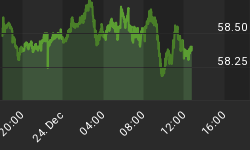When doing a technical analysis, one will often compare indicators such as Relative Strength when trying to determine which index is stronger.
But, for non-technicians, or for a confirmation, you could compare the number of New Highs and New Lows occurring on different indexes.
Let's do that by looking at the number of 20 day New Highs, and 20 day New Lows for each index in the chart below.
Now the first thing you should notice is that there are many more New Lows compared to the number of New Highs. That tells you the market balance is favoring the down side ... and that tells you that your odds of being successful on the long side are not as good as being on the short side based on yesterday's data. (See the chart below.)
Next, let's look at those numbers on a percentage basis and see what they tell you. First, add the two numbers together and then divide the New Highs by the total. That tells you the following: Out of the total number of stocks making New Highs and New Lows, only 37% were New Highs on the NYSE Index.
That obviously means that 63% were making New Lows on the NYSE.
When you look at the NASDAQ, only 21% were New Highs which meant that 79% were making New Lows.
From that, you can infer that the NYSE was the strongest of the two indexes, and the NASDAQ was the weakest of the two indexes.
Additionally, if you divide the number of New Lows by the number of New Highs, you will see that there are more than twice as many stocks making New Lows as opposed to New Highs on the NASDAQ compared to the NYSE. So, that says ... if you decided to go short, the NASDAQ had the advantage because the New Low to New High Ratio was 3.7 versus 1.7 on the NYSE.
Analyses like this are about improving your odds when trading and can be applied to other criteria as well. For example ... at the close yesterday, stocks with prices above $10 were making New Lows at double the ratio of stocks that were below $10.
Have a great weekend, and we will see you on Monday.

















